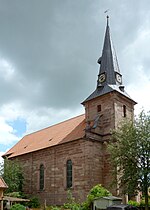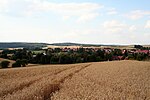European Bread Museum
Food museums in GermanyGerman museum stubsLower Saxony building and structure stubsMuseums in Lower Saxony

The European Bread Museum (German: Europäisches Brotmuseum), in Ebergötzen in South Lower Saxony, Germany, is a rurally located museum dedicated to the historical development of breadmaking and related subjects in Europe. Through displays and demonstrations, the museum shows the history of grain farming in Europe, processing of grain, milling, baking of bread, bread in art, and other subjects. Gardens, functioning re-constructed ovens (beginning with the neolithic), a windmill and a watermill, bread wagons, farm machinery, documents, and tools and equipment for preparing bread are among the objects to be seen.
Excerpt from the Wikipedia article European Bread Museum (License: CC BY-SA 3.0, Authors, Images).European Bread Museum
Göttinger Straße, Samtgemeinde Radolfshausen
Geographical coordinates (GPS) Address Phone number Website External links Nearby Places Show on map
Geographical coordinates (GPS)
| Latitude | Longitude |
|---|---|
| N 51.5688888889 ° | E 10.0997222222 ° |
Address
Europäisches Brotmuseum
Göttinger Straße 7
37136 Samtgemeinde Radolfshausen (Ebergötzen)
Lower Saxony, Germany
Open on Google Maps









